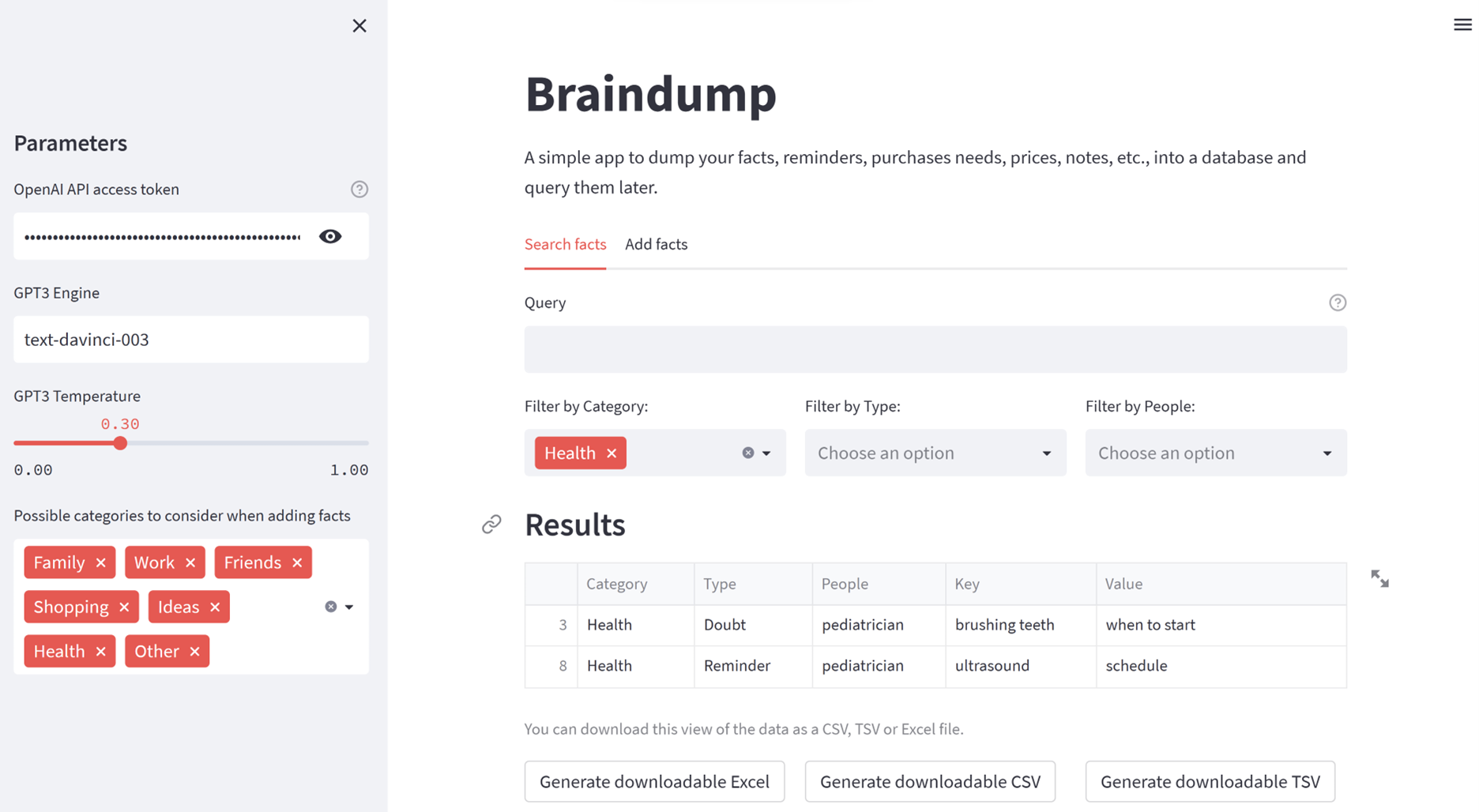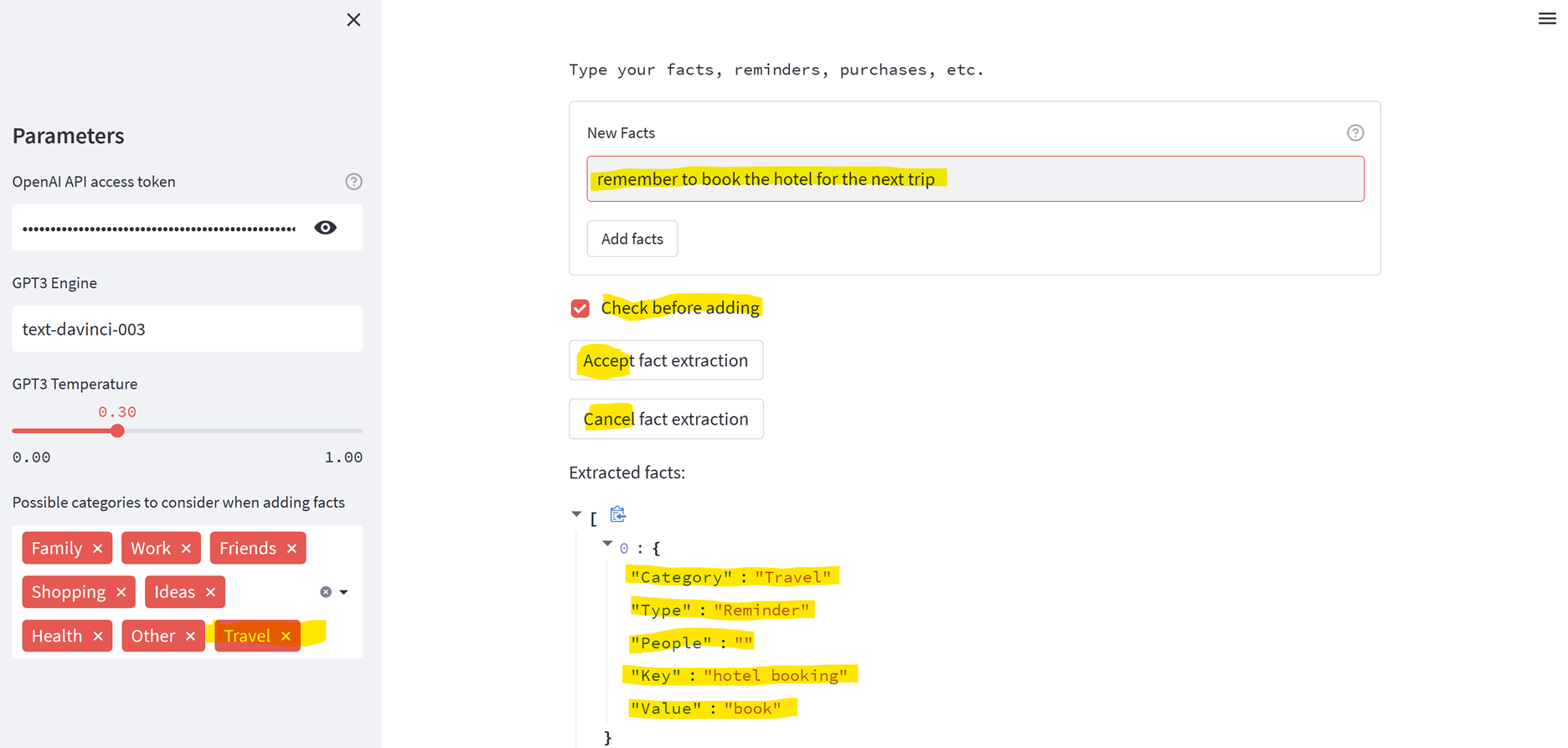Update (November 2023): new GPT-3.5-Turbo version to be preferred. I added a new version supporting the Chat Completion API (tested with GPT-3.5-Turbo). Appropriate subfolders (gpt-3, gpt-35-turbo) now contain the original and the new version. Other than the model change and corresponding asjustments, they are the same, but gpt-35-turbo is to be preferred, because GPT-3 completion is deprecated.
Braindump is a prototype application for taking notes and converting them to a database that can be more easily queried. Just type what is in your mind and the application properly classifies, slices, and stores it for later use. It was built as a demo to show how to leverage GPT-3 to build applications starting with Proofs-of-Concept, as described in my Data Science @ Microsoft tutorial, "Building GPT-3 applications — beyond the prompt". You can use it both to follow the tutorial and as a starting point for your own studies and applications (e.g., by reusing the utility functions and overal program structures in your own, different, problems).
It is a simple Python application that leverages Streamlit to provide a web interface. To actually call the GPT-3 model, you need to have a working OpenAI API key. At the time of writing, once you create your account, you get some free credits that should be enought to follow the tutorial and get started with the application. The application should also work with Azure OpenAI Service instead of the original OpenAI offer, though I have not yet tested it there.
Besides the application itself, this repository includes the studies, in the form of Jupyter notebooks, that led to it.
The UI for searching looks like this:

To add facts, the UI is as follows, including an optional manual inspection of the model interpretation:

The application has been tested on Python 3.8 (GPT-3) and 3.10 (GPT-3.5-Turbo). The main libraries you'll need are: openai, streamlit, pandas, notebook, pytest. You can install them manually, or follow the below procedure to create a new environment and install them automatically. Note that for the older codebase you will need an older version of the openai library.
To run the application:
- It is recommended that you run Python 3.10+, from the Anaconda distribution, which can be obtained here.
- To ensure dependencies are properly installed, you can first create a new environment just for this application using
conda create -n braindump_py310 python=3.10 - Activate the new environment using
conda activate braindump_py310 - For GPT-3.5-Turbo (recommended), install the dependencies listed in
requirements.txt. You can do this by runningpip install -r requirements.txtfrom the root of the project. For the original GPT-3 version (deprecated), use therequirements.gpt3.txtinstead, to get the older dependencies necessary for its operation. - Obtain you need to have a working OpenAI API key and make it available as an environment variable called
OPENAI_API_KEY. - Finally, launch the application from the root of the project. On Windows:
run.gpt3.bat(GPT-3 version) orrun.gpt35turbo.bat(GPT-3.5-Turbo version); on Linux:run.gpt3.sh(GPT-3 version) orrun.gpt35turbo.sh(GPT-3.5-Turbo version).
To run the studies:
- Follow the steps above, except the last one.
- Open the desired Jupyter notebook under
notebooks/with your favorite Jupyter client (personally, I use VS Code a lot for that).
The project is structured as follows:
notebooks/: Jupyter notebooks used for prompt engineering.src/: source code for the final application.src/gpt-3: sources for the original GPT-3 version (deprecated).src/gpt-3.5-turbo: sources for the GPT-3.5-Turbo version (recommended since November 2023).
data/: data stored by the application.tests/: unit tests for the application.tests/gpt-3/: tests for the original GPT-3 version (deprecated).tests/gpt-3.5-turbo/: tests for the GPT-3.5-Turbo version (recommended since November 2023).
docs/: documentation and related assets.
The approach is presented in detail in my Data Science @ Microsoft tutorial, "Building GPT-3 applications — beyond the prompt". Nevertheless, let me highlight some key points here:
- Large Language Models, notably GPT-3, GPT-3.5-Turbo and GPT-4, offer a relatively easy and very flexible way to build some types of software. However, considerable additional Software Engineering aspects are required to actually build a robust and usable application.
- Proofs-of-Concept (PoC) are great to explore the capabilities of new technologies and demonstrate value quickly and at low cost. They thus provides a way to secure further investents if waranted. Since the application of LLMs like GPT-3 remains a very new area, PoCs are a great way to explore the space and learn.
- A gradual, iterative, process is the best way to build such PoCs and applications. Start with a simple use case and add features and complexity as you go.
- In this manner, it is now possible to achieve impressive results with relativelly little effort. Things that would be too costly or even impossible to do previously are now feasible. It is thus a great way to improve productivity -- both for individuals and for organizations. Time to explore and experiment with formerly unthinkable projects!
In terms specific phases, the following is advisable
- Try the OpenAI Playground with some very simple cases to see if the idea merits more work.
- Once you decide to proceed, write a simple specification consisting of the basic data structures you'll manipulate and some examples of inputs and outputs.
- Break the problem in subproblems, and determine which ones can be handled by GPT-3 or similar models.
- Gradually and iterativelly engineer your prompts, preferably using Jupyter notebooks.
- Once satisified with the quality of the prompts, encapsulate them and the auxiliary mechanisms in an engine.
- Build a UI for your engine, preferably with something like Streamlit or Gradio, both of which produce good results very fast.
- Show the PoC to stakeholders and iterate as appropriate.
MIT License
Copyright (c) 2023 Paulo Salem da Silva
Permission is hereby granted, free of charge, to any person obtaining a copy of this software and associated documentation files (the "Software"), to deal in the Software without restriction, including without limitation the rights to use, copy, modify, merge, publish, distribute, sublicense, and/or sell copies of the Software, and to permit persons to whom the Software is furnished to do so, subject to the following conditions:
The above copyright notice and this permission notice shall be included in all copies or substantial portions of the Software.
THE SOFTWARE IS PROVIDED "AS IS", WITHOUT WARRANTY OF ANY KIND, EXPRESS OR IMPLIED, INCLUDING BUT NOT LIMITED TO THE WARRANTIES OF MERCHANTABILITY, FITNESS FOR A PARTICULAR PURPOSE AND NONINFRINGEMENT. IN NO EVENT SHALL THE AUTHORS OR COPYRIGHT HOLDERS BE LIABLE FOR ANY CLAIM, DAMAGES OR OTHER LIABILITY, WHETHER IN AN ACTION OF CONTRACT, TORT OR OTHERWISE, ARISING FROM, OUT OF OR IN CONNECTION WITH THE SOFTWARE OR THE USE OR OTHER DEALINGS IN THE SOFTWARE.